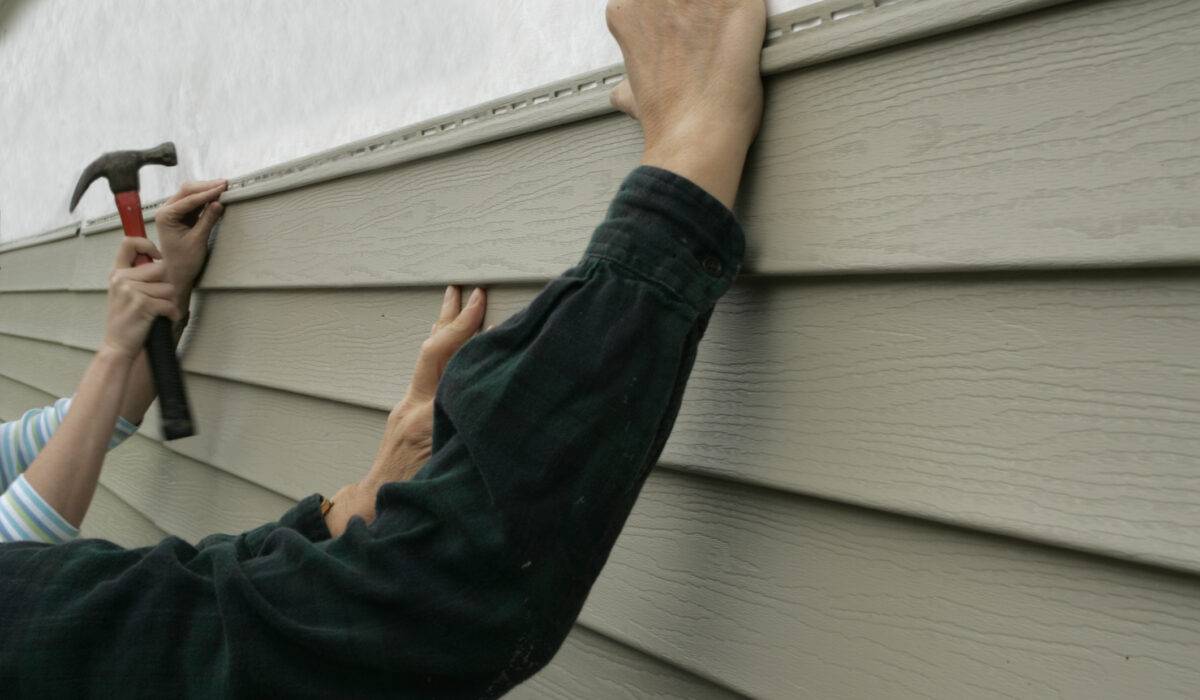Siding Repair vs Replacement (Which is the Best Option?)
Siding plays an important role in your home’s energy efficiency, appearance, and protection from the elements. Like everything else about the home, it needs maintenance and care. When it comes time to replace your siding, however, homeowners like you often ask the question: which is my best option? Siding repair, or replacement? In this article from Harford Roofing & Exteriors, we’ll take a look at the top reasons to repair or replace, and help you decide which is best for your home (and wallet.)
Siding Repair: Signs Your Home Needs It
Not only is siding play an exquisite role in your home’s curb appeal, but it’s also a critical part of your home’s protection against the elements and providing structural integrity. Of course, because it’s the first line of defense against rain, snow, direct sun, and harsh winds, it sustains wear over the years. Before you know it, the siding will begin to look warped or damaged, or just lose its original luster.
There are quite a few signs that will tell you when its time to replace the siding, such as:
Cracks and Gaps
Cracks and gaps in siding are urgent indicators that you need repairs sooner than later. This kind of problem isn’t something you can wait around on unless you want to spend more on repairs in the long-term. These openings can allow water and pests to penetrate the home, causing more extensive damage over time. Early intervention can save you from hefty repair bills and frustration in the future.
Rotting or Warping
If you see any areas of the siding beginning to rot or warp, take it as an urgent sign that the underlayer might be in a compromised condition. Use a screwdriver or similar object to probe the warped siding gently and test the rigidity of the siding. If the layer underneath the siding is soft, it’s a clear sign that you need to address the issue promptly with a siding repair specialist.
Fading or Peeling Paint
While this isn’t as critical as cracks or rotting, you’ll find that peeling paint and fading siding will leave it looking drab and old. High-quality siding typically maintains its color for at least 8-10 years. If you notice the color fading before that period, it may indicate that the siding is nearing the end of its functional lifespan and may need repair or replacement.
Unusual Noises
Siding that rattles or makes noise in the wind can be indicative of loose nails, or other issues that compromise its integrity. This symptom might seem easy to dismiss, but it acts as an early warning system for more severe issues. If left unaddressed, this could lead to worse problems with a heftier cost. You may also see an increase in energy bills as the siding deteriorates.
Signs Your Siding Needs to be Replaced
Siding repairs often go unnoticed until it’s too late, which can lead to more severe problems along the exterior of your home. Letting these problems go unaddressed can lead to long-term structural problems, as well as a lowered property value. Fortunately, these problems can be resolved fairly quickly with the help of an experienced and licensed siding contractor.
In many cases, if a siding problem is left unaddressed for too long, or if it becomes severe enough, the siding must be replaced instead of being repaired. These issues include:
 Persistent Mold or Mildew
Persistent Mold or Mildew
Mold or mildew near the seams of the siding could be a sign of water infiltration. If the problem is widespread, this is a definite sign you should consider a full siding replacement to further protect your home. This is particularly true in northern Maryland, where we receive a lot of snow in the winter. Ignoring mold can lead to health issues for your family and more extensive, costly repairs in the long run.
Frequent Need for Repairs
If you find yourself repeatedly calling up the local siding repair company to patch up the siding of your home, it might be more cost-efficient to replace it entirely. Consistent repairs are a signal that the siding is nearing – or have reached – the end of its functional lifespan.
Hikes in Energy Bills
An unexplained rise in your heating or cooling costs could be a result of poor siding insulation. Proper siding should provide a protective barrier that keeps your home energy-efficient. If you’ve noticed a steady climb in your bills, your siding might be the culprit. Replacing it will not only improve your home’s value but also keep your energy costs low.
Outdated Appearance
When considering repairs for selling the home, it’s important to take the exterior of the home into consideration just as much as the interior. If your siding looks outdated, it could affect the resale value of your home. Even if you’re not planning on selling soon, upgrading your siding can rejuvenate your home’s appearance and enhance your living experience.
Why It’s (Often) Better to Replace Your Siding Than Repair It
In most cases, siding repairs are fine for when there has been direct damage to it, such as cracks after a particularly bad storm. These spot repairs are cost-effective and keep your siding performing at its best, when the siding is still functional and new.
When the siding is nearing the end of what is called its “functional lifespan”, it’s usually time to start considering the cost benefits of replacing the siding over repairing it. This is when the siding has protected your home long enough, or has sustained enough damage, to warrant full replacement rather than a quick spot repair.
While repairs may seem like a more cost-effective solution, they are often a band-aid over a larger problem. It’s important to understand when your siding has run its course and replacement winds up becoming the most cost-effective solution. This is especially the case when the siding is chronically in need of repairs, or starting to affect the energy efficiency of the home.
When you replace the siding, you are also improving the home’s resale value and refreshing the appearance of the entire home. It’s easy to forget how dim and worn the siding looks until you see it compared to brand new siding.
Furthermore, when you replace the siding on your home, you’ll get the benefits of a refreshed warranty period from the manufacturer, and you’ll enjoy peace of mind knowing your siding is protecting your home.
Can You Replace Just Pieces of Siding?
Yes, you can typically replace just a few pieces of siding that are damaged rather than replacing the whole thing. This is known as a spot repair, which may not address any severe underlying issues. This type of repair is best performed when the siding is in good condition, but has minor issues to address.
How Often Should House Siding Be Replaced?
Vinyl siding typically lasts 20 to 40 years, while fiber-cement can endure up to 50 years. If you have wood siding, expect a lifespan of around 20 to 40 years, depending on maintenance. Keep in mind that not all siding is made equal and its functional lifespan may be different than these estimates.
Does Replacing Old Siding Increase Home Value?
According to industry studies, homeowners can expect to recoup up to 80% of the siding replacement cost through increased home valuation. New siding enhances curb appeal, improves energy efficiency, and offers better protection against the elements.
Does New Siding Go Over Old Siding?
No, new siding should always be placed after removing the old siding. Adding new siding on top of old siding can mask underlying issues like rot or structural damage, leading to more significant problems down the line. Removing the old siding allows for a thorough inspection of the underlying structure and ensures better adhesion of the new material.
How to Find the Right contractor to Repair or Replace Your Siding
Before you jump into an agreement with just any siding contractor, it’s important that you know whether they have your interests at heart. Talk with them and get a feel for how they treat their customers. You’ll also want to look for someone with a proven track record of quality repairs and replacements, as well as the proper licensure and certifications for siding work.
At Harford Roofing & Exteriors, we are a family-owned and -operated business, ensuring your quality of service is top notch, with licensure and certification for roofing, siding, and other areas of home improvement.
An Overview of Different Types of Siding
You’ll find that the next step, after finding a contractor to help you with your siding repair or replacement, is choosing what type of siding you want. The most common choice is to use the same siding that previously existed on the home, but you may want to upgrade. (1)
Vinyl siding is cost-effective and low maintenance, but lacks in long-term durability. Most homes have vinyl siding, unless you are closer to the coastline.
Fiber cement siding is a choice that is becoming popular in Maryland, providing a blend of durability and quality appearance, but it comes at a slightly higher cost than vinyl.
“Fiber cement siding is especially good for homeowners who live in an intense climate, because it can stand up to harsh weather, including hail and strong winds.”
—Forbes
Wood siding offers a classic sea-shanty look, but requires a lot of regular upkeep to prevent insects and rot.
Why Choose Harford Roofing & Exteriors
At Harford Roofing & Exteriors, we are committed to giving you the best bang for your buck with top-notch materials and skilled craftsmanship. As a family-owned and operated business, we believe in providing quality services to the northern Maryland region, keeping you safe and warm throughout the winter, and comfortable and protected throughout the summer.
Replacing your siding not only rejuvenates your home but also serves as a prudent financial decision, contributing to both immediate and future benefits for your home value. We understand that long-term investment takes a lot of work, and we’re here to help you make the most of it. At Harford Roofing & Exteriors, our experienced siding contractors are licensed, bonded, and insured. We have a five-star rating on Google and strong ties to our Harford County community. Call us today at (443) 292-6020 for an onsite assessment, or request a quote online on our website. We’ll help you determine whether you need repairs or replacement based on your home’s existing siding.
References:</span?
1. Forbes, 9 Types of Siding to Consider For Your Next Home Remodel, https://www.forbes.com/home-improvement/siding/types-of-siding/

